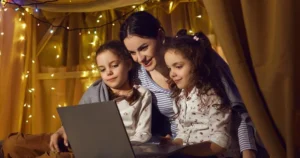Learn about online reputation
Find out more about how an online reputation is created and tracked to help children understand the long-lasting effects of what they share online.
 Close video
Close video
Quick tips
What makes up an online reputation?
The internet keeps a record of everyone’s online behaviour – the photos we upload, the comments other people make about us and the things we buy. This is our online reputation. It’s important children understand how to manage their online reputation and the impacts for them of a negative online reputation.
- Online reputation facts and statistics
- How is my child’s online reputation formed?
- What are the effects of negative online behaviour?
- Recommended resources
How is my child’s online reputation formed?
Many parents nowadays post their baby’s scan picture and photos of their newborn on social network pages. Children themselves start sharing information from a young age – the result is that by the time they are 18, a permanent and often substantial record will exist about them.
What happens if that information is inaccurate, or is the result of sexting or bullying? Once uploaded, such information is difficult to erase or change and could have a long-lasting impact especially if shared on social media.
Emma Robertson of Digital Awareness UK shares advice on how to help your child manage their digital footprint.
 Close video
Close video
What are the effects of negative online behaviour?
Interfering with friendships and relationships
A nasty comment made about someone privately can soon find its way to that person or even more widely if it is shared by the recipient.
Impact on educational and career prospects
Future employers and admissions officers often search for information about candidates by looking for them online. Research shows that 70% of employers use social media to screen potential employees.
Disrupting future credit ratings
If a child’s identity is stolen and used to obtain credit it may not be noticed for many years.
How do I know what sort of online reputation my child has?
You can find out more about your child’s online reputation by taking the following steps:
- Search for your child online – use different search engines and check using your child’s whole name and other identifying information such as town or nickname.
- Also, search on Google images and look at the kind of information these searches reveal – are the comments, photos, links appropriate? Do they include private information like their school or address? If your child has a blog, what does it say?
- If your child is a member of a social networking site, consider joining it yourself and ask to be your child’s online connection, or get another trusted adult to do this. Be aware that some children may have two or more profiles: one they share with their parents and one they use for talking to their friends. Put all the information together and see what it says about your child. Does the picture it portrays feel right to you? If not, see what you can do to improve it.
Recommended resources
Featured online safety articles
 Expert opinion
Expert opinion
Protecting children from online violence
Learn how exposure to violent content online impacts young users.
 Press release
Press release
New report reveals how risky and unchecked AI chatbots are the new ‘go to’ for millions of children
Our new report reveals that the majority of children are using AI chatbots, but many don't question if they're reliable
 Research
Research
Rising harms, new rules: Why the Online Safety Act matters
Outlining what our data reveals about children’s experiences, why the Children Codes must be seen as a starting point and further action that's needed.
 Press release
Press release
New report reveals 7 in 10 children experience harm online, but most don’t report it
Our new report reveals 7 in 10 children experience harm online, but most don’t report it
 Research
Research
Understanding and improving how children report online harm
Explore how children engage with reporting tools on the platforms they use.
